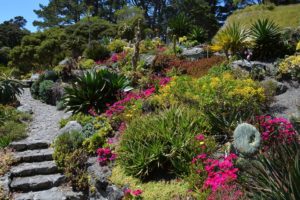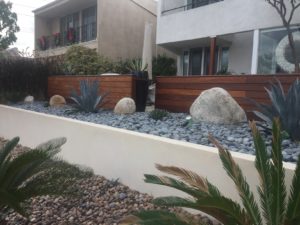Gravel garden in Orange County, California, offers an enchanting blend of aesthetics and practicality, thriving under the region’s Mediterranean climate. In this idyllic coastal setting, where sunshine is abundant and rainfall is moderate, you have the perfect canvas to experiment with diverse plant species, from drought-resistant succulents to aromatic lavender and vibrant California poppies. The well-draining gravel substrate allows you to craft a garden that showcases the stunning variety of flora that thrives in the area, creating a tapestry of colors and textures that change with the seasons.
As you embark on your journey to cultivate and sustain a beautiful gravel garden, we present ten essential tips to ensure your outdoor haven remains a vibrant and low-maintenance oasis, covering fundamental maintenance practices and innovative ideas to infuse your outdoor space with creativity, sustainability, and a touch of Mediterranean allure.

1. Control Your Weeds
Weeds can quickly take over a gravel garden if left unchecked. To maintain a pristine look, regular weeding is essential. Here’s how to do it effectively:
- Weed Barrier Membranes: These are excellent for preventing weed growth through the stone chippings and protecting your gravel from soil infiltration. If you have areas with plants in your gravel garden, you can snip holes in the weed membrane to allow the plants to grow while still preventing weeds.
- Weed-Killing Options: If a weed membrane isn’t an option, use weed killer for any unwanted weeds or grass that grow in the gravel area. There are plenty of weed killers, including organic products that effectively remove unwanted weeds and grass.
2. Choose Hard-Wearing Gravel
Selecting the right type of gravel is crucial for easy maintenance. Hard-wearing chippings such as Basalt, Granite, Quartz, or Flint stones won’t require topping up as often as softer chippings like Limestone or Cotswold. Keep in mind that marble and dolomite products may discolor more easily in damp areas.
3. Rake the Gravel into Rows
To keep your gravel garden looking sharp and prevent bald spots, rake the gravel into rows using a sturdy garden rake. This technique can be particularly effective with smaller chippings and can even create unique patterns in your gravel for added aesthetics.
4. Use Edging for Definition
Defining the borders of your gravel garden with materials like bricks, wooden sleepers, or metal strips is essential. Edging prevents gravel spillage, acts as a barrier against weeds, and enhances the garden’s visual appeal. It can also be used to style a Japanese Gravel Garden or create patterns in your gravel for a unique design.
5. Seasonal Pruning and Plant Care
While gravel gardens are known for their low maintenance, it’s essential to pay attention to any plants you’ve incorporated into the design. Prune, mulch, and fertilize as needed to maintain healthy growth. You can also keep plants in pots, matching them with the gravel’s color tones or creating attractive contrasts.
6. Regular Inspection
Schedule regular inspections to catch issues early and maintain your garden’s beauty. This includes:
- Weed Check: Look for any weeds that might have popped up and remove them promptly.
- Drainage Inspection: Ensure that water flows freely through your gravel garden and doesn’t pool in any areas. Adjust the slope if necessary.
- Debris Cleanup: Keep an eye out for leaves, sticks, or other debris that may have blown into your garden, and remove them promptly.
7. Proper Lighting
Enhance the beauty and usability of your gravel garden by installing outdoor lighting:
- Path Lighting: Illuminate walkways and paths with low-voltage path lights to improve safety and aesthetics, especially during the evening.
- Accent Lighting: Use spotlights or well lights to highlight specific plants, sculptures, or features within your garden.
- String Lights: String lights above your gravel garden can create a cozy, inviting atmosphere for evening gatherings.
8. Periodic Resurfacing
Over time, gravel gardens may need a bit of a facelift. This involves:
- Gravel Replenishment: As mentioned earlier, periodically add a thin layer of fresh gravel to maintain the desired depth and appearance.
- Pattern Refinement: Consider refreshing or redesigning decorative patterns or rows in your gravel for a new look.
9. Keep Leaves at Bay
Invest in a leaf blower, especially during the autumn months, to quickly remove leaves and prevent discoloration of lighter gravels. Picking up each leaf by hand can be a slow and painstaking way of removing them, so a leaf blower can be a more efficient option.
10. Water Your Plants
Don’t forget to water your plants on a regular basis. The best types of plants to have in your gravel garden include herbs, perennials, and ornamental grasses. These not only look gorgeous but have the most success growing in a gravel environment. Keeping your plants alive will also prevent any unsightly debris from forming on your gravel.

In conclusion, maintaining a gravel garden in your Orange County home can be a delightful and straightforward task when you follow these ten simple ways. From controlling weeds to choosing the right gravel and implementing proper lighting, integrating these maintenance practices into your routine will ensure that your gravel garden remains a beautiful and hassle-free outdoor oasis for years to come. By following these tips, you can enjoy the tranquility and charm of your gravel garden with minimal effort.
Want to explore more ideas? Check out Pros and Cons of Landscape Gravel in Backyard Design.


